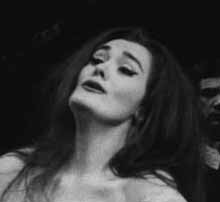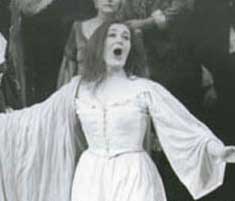Key Word Search
Multi-Field Search
Browse
Repertory Report
Performers Report
Contacts
Met Opera Website
Lucia di Lammermoor
Metropolitan Opera House, Sun, November 26, 1961
Debut : Silvio Varviso, Joan Sutherland
Lucia di Lammermoor (300)
Gaetano Donizetti | Salvadore Cammarano
- Lucia
- Joan Sutherland [Debut]
- Edgardo
- Richard Tucker
- Enrico
- Lorenzo Testi
- Raimondo
- Nicola Moscona
- Normanno
- Robert Nagy
- Alisa
- Thelma Votipka
- Arturo
- Charles Anthony
- Dance
- Nancy King
- Dance
- Howard Sayette
- Conductor
- Silvio Varviso [Debut]
- Director
- Désiré Defrère
- Designer
- Richard Rychtarik
- Costume Designer
- Ruth Morley
- Choreographer
- Zachary Solov
Lucia di Lammermoor received seventeen performances this season.
Ruth Morley designed the costumes only for the ballet.
Review 1:
Review of Irving Kolodin in The Saturday
JOAN SUTHERLAND came, sang, and conquered the Metropolitan Opera House in her awaited debut as Lucia. This mode of putting it means there was never much doubt of her ability to deliver Donizetti's music with distinction. But how it would sound in a theatre that has devoured many another famous voice was something else. This, however, was quickly determined after her entrance aria in the Fountain Scene: broad, fluent, perfectly in pitch, fastidious in style, a treat to the ear and an incitement to the enthusiasm of an audience that filled every saleable spot.
Thereafter it was a matter of sitting back to enjoy a superlative demonstration of vocalism by a grand mistress of the ancient, ever new art. As she developed the part, through the duet with Edgardo, the angry episode with her brother, into the sextet, the accumulating evidence pointed to one thing in particular: this is a voice consistent in timbre through two octaves (E flat to E flat in this part) with scarcely a break-full, ringing, and clear at the top, solid in the middle, viola-mellow at the bottom.
Her "Mad Scene" was a thoroughly studied thing in itself, altogether suited in character to what had preceded, but sufficiently illuminated by highlights to be the shining climax to the whole. Here she allowed herself more freedom in ornamentation than previously, working out delicate traceries of figuration in and around the melodic line, stitching in a bit of petit-point staccato, coasting cleanly down a descending scale, and finally demonstrating her prize beyond price-a perfectly controlled trill that was not a mere glorified vibrato but a swift, even beat of two notes perfectly interchanged. Finally? Not quite. She ended her evening's work with a bright, firm, fully produced high E flat that is still ringing in the ear as this is written.
So much for the unquestionable. What of the questionable? Not her musicianship, certainly, which is near faultless, nor her stage deportment, which is serious, considerate of her associates, and more modest that that of most with a tenth of her accomplishments.
When it comes to character portrayal, however, Miss Sutherland has work to do. Prior to the "Mad Scene," she projected Lucia as a maid all sad of mien, cast over with a sense of tragedy to come, with a mid-century (nineteenth) slant of the body to compose her tall figure in an angular attitude of "suffering." For the "Mad Scene." she wore her auburn hair at shoulder length and a faraway look that searched out the cleverly contrived action (probably the influence of Franco Zefferelli, who directed her at Covent Garden) to fill in musical gaps with pantomime and movement. One especially apt incident accompanied an echo effect in the music, in which she turned her back to the audience, apparently listening (to herself). But all the artifice did not generate compulsion, develop conviction, or magnetize the observer into involvement with anything but vocal virtuosity. There is so much of this, however, that one could only say: Well done and welcome, Miss Sutherland; may your prime be long and productive.
In the old-fashioned way, her entrance was accompanied, physically as well as musically, by her own conductor, the young Swiss Italian Silvio Varviso. There is nothing in the least old-fashioned about his treatment of the score, except a virtuous attention to detail, a well-discriminated distribution of emphasis between pit and stage. Richard Tucker sang well, sometimes brilliantly, as Edgardo, while indulging some petty tenoristic privileges in costuming and action; but Lorenzo Testi's blatantly overstressed Ashton did not belong on the same stage with Sutherland (or Tucker).
Review 2:Review :
Joan Sutherland's Met Debut Teases Memory" Maybe Nothing Ever Like It
The Metropolitan Opera season, which was almost cancelled, has produced the debut of a soprano, Joan Sutherland, of Australia, who is almost unimaginably good. Resultantly, the Sunday (26) night audience went nearly berserk with delight during and after the climaxing mad scene in "Lucia de Lammermoor." Although explosions of enthusiasm are familiar enough, though never common, at the Met nothing comparable is recalled in recent times. There wasn't applause but wild beatings of palms; not bravos but roars of exultant appreciation. There were 10 genuine, unforced, prolonged solo curtain calls. At the sixth the examples of a few who were standing became the complete audience.
Suffice that with this Australian's arrival a box-office sensation, a queen among divas and opera history were all made simultaneously. It was simply not possible to find anything to quibble about. Even the creaky old libretto suddenly seemed exciting.
That the audience anticipated itself was clear when they broke into her first entrance, a practice frowned on at the house and destructive of illusion and mood. Actually the Australian has sung many times in U.S. concert and her London label disks have established the amazing richness of her voice, especially in the top range, which in "Lucia" included a smashing, full-throated high E. Her performance all the way, the trills and flawless production of rounded tones gave new pulsation to an opera which is frequently more hokum than art.
In the presence of this kind of soprano all the other singers assumed fresh interest. Richard Tucker sang his head off, Lorenzo Testi was excellent as the tyrannical brother. As for the sextet it had a powerhouse impact. The evening contained the further interest of including a new youthful conductor from Switzerland, Silvio Varviso. He made a very good impression indeed.
No point in complicating the simple fact of a once-in-a-generation eruption of performing genius. Miss Sutherland, tall, completely the mistress of her role, and pretty good actress to boot, was that rara avis, a promised glory that exceeded hopes. She is the kind of talent that old-timers often refuse to believe any longer lives.
Joan Sutherland as Lucia di Lammermoor. Photographs by Louis Melançon.
Search by season: 1961-62
Search by title: Lucia di Lammermoor,
Met careers
- Silvio Varviso [Conductor]
- Joan Sutherland [Lucia]
- Richard Tucker [Edgardo]
- Lorenzo Testi [Enrico]
- Nicola Moscona [Raimondo]
- Robert Nagy [Normanno]
- Thelma Votipka [Alisa]
- Charles Anthony [Arturo]
- Nancy King [Dance]
- Howard Sayette [Dance]
- Désiré Defrère [Director]
- Zachary Solov [Choreographer]
- Richard Rychtarik [Designer]
- Ruth Morley [Costume Designer]

